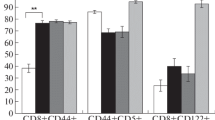Summary
The in vitro cytotoxic response against H-2 d and H-2 b SV40-transformed fibroblasts was studied in a 40-h 3H-proline assay. A very low response against SV40 TASA is associated with the H-2d antigens on target cells: however, SV40-transformed H-2d cells are as immunogenic as SV40-transformed H-2b cells and prime against H-2b target cells. The data concerning in vitro amplification of the anti-SV40 TASA response and the involvement of cyclophosphamide-sensitive suppressor populations confirm the comparable immunogenicity of SV40-transformed H-2d and H-2b cells and cannot account for the haplotype-related behavior observed with SV40-transformed target cells. The study of the response against allogeneic SV40-transformed cells shows the reverse situation: the lower cytotoxic response is now associated with the H-2b antigens on SV40-transformed cells. As suggested by the data presented here, an interaction between SV40 TASA and H-2 antigens might be postulated.
Similar content being viewed by others
Abbreviations
- B6:
-
C57BL/6 mice
- B6D2F1 :
-
(C57BL/6xDBA/2)F hybrid mice
- CB6F1 :
-
(BALB/cxC57BL/6)F1 hybrid mice; E
- T:
-
effector-to-target-cell ratio
- FCS:
-
fetal calf serum
- PBS:
-
phosphate-buffered saline
- TASA:
-
tumor-associated specific antigens
References
Chen TR (1977) In situ detection of mycoplasma contamination in cell cultures by fluorescent Hoechst 33258 stain. Exp Cell Res 104:255–262
Fujiwara H, Shearer GM (1981) Genetic control of cell-mediated lympholysis to trinitrophenyl (TNP)-modified murine syngeneic cells. I. Expression of Ir gene function at the cytotoxic precursor and helper cell levels in the response to TNP-H-2b self. J Immunol 126:1047–1051
Gilheany P, Arora IK, Levy RB, Shearer GM (1981) H-2-linked genetic control of murine cell-mediated lympholysis to autologous cells modified with high and low concentrations of fluorescein isothiocyanate. Cell Immunol 59:97–105
Glaser M (1979) Regulation of specific cell-mediated cytotoxic response against SV40-induced tumor associated antigens by depletion of suppressor T cells with cyclophosphamide in mice. J Exp Med 149:774–779
Glaser M, Lotan R (1979) Augmentation of specific tumor immunity against a syngeneic SV40-induced sarcoma in mice by retinoic acid. Cell Immunol 45:175–181
Gooding L (1979) Specificities of killing by T lymphocytes generated against syngeneic SV40-tranformants: studies employing recombinants within the H-2 complex. J Immunol 122:1002–1008
Gooding L (1980) Anomalous behaviour of H-2Kb in immunity to syngeneic SV40-transformed cells: evidence for cytotoxic T cell recognition of H-2/SV40 membrane antigen complexes. J Immunol 124:1612–1619
Henin Y, Gomard E, Gisselbrecht S, Levy JP (1979) Significance of the proline assay in the study of anti-MSV cell-mediated immune reactions. Br J Cancer 39:51–63
Knowles BB, Koncar M, Pfizenmaier K, Solter D, Aden DP, Trinchieri G (1979) Genetic control of cytotoxic T cell response to SV40 tumor-associated specific antigen. J Immunol 122:1798–1806
Maki T, Howe ML (1976) Primary in vitro sensitization of murine lymphocytes against isogeneic and allogeneic cells transformed by Simian Virus 40. J Immunol 117:1398–1401
Nanni P, De Giovanni C, Galli MC, Grilli S, Lollini PL, Nicoletti G, Prodi G (1981) Minor histocompatibility antigens do not enhance BALB/c anti-SV40 TASA response. Br J Cancer 44:588–591
Pfizenmaier K, Pan SH, Knowles BB (1980) Preferential H-2 association in cytotoxic T cell responses to SV40-associated specific antigens. J Immunol 124:1888–1891
Röllinghoff M, Starzinski-Powitz A, Pfizenmaier K, Wagner H (1977) Cyclophosphamide-sensitive T lymphocyte suppress the in vivo generation of antigen specific cytotoxic T lymphocytes. J Exp Med 145:455–459
Simpson E, Matsunaga T, Brenan M, Brunner C, Benjamin D, Hetherington C, Hurme M, Chandler P (1980) H-Y antigen as a model for tumor antigens: the role of H-2 associative antigens in controlling anti-H-Y immune responses. Transpl Proc 12:103–106
Stutman O (1977) Role of H-2 histocompatibility in generation of cell-mediated cytotoxicity against virus-induced mammary tumors in C3H mice. Transpl Proc 9:1153–1155
Stutman O, Shen FW, Boyse EA (1977) Ly phenotype of T cells cytotoxic for syngeneic mouse mammary tumors: evidence for T cell interactions. Proc Natl Acad Sci USA 74:5667–5671
Trinchieri G, Aden DP, Knowles BB (1976) Cell-mediated cytotoxicity to SV40-specific tumor-associated antigens. Nature 261:312–314
Warnatz H, Krapf F (1976) Studies on the specificity of in vitro induced lymphocytotoxicity to SV40-transformed fibroblasts. J Immunol 117:981–985
Author information
Authors and Affiliations
Additional information
This work was supported by grant no. 81.01423.96 of Progetto Finalizzato “Controllo della Crescita Neoplastica” from C.N.R., Italy. C.D.G. and G.N. are in receipt of a training grant from C.N.R., Italy; P.-L.L. is in receipt of a fellowship from Fondazione Anna Villa Rusconi, Varese, Italy
Rights and permissions
About this article
Cite this article
De Giovanni, C., Grilli, S., Lollini, PL. et al. Inverse relationship between anti-SV40 TASA and anti-H-2 cytotoxic responses. J Cancer Res Clin Oncol 106, 117–122 (1983). https://doi.org/10.1007/BF00395389
Received:
Accepted:
Issue Date:
DOI: https://doi.org/10.1007/BF00395389




